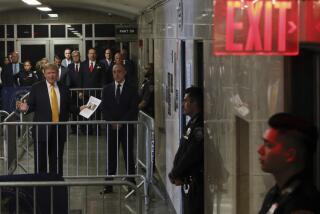Businesslike Jury Answers Yes. . .Yes. . .Yes
- Share via
The jurors filed in, looking weary. Wearing their coats. Ready to go home. They kept their faces doggedly blank, as they had through so much of the trial. No thumbs up, no smiles, no sly “we’re with you” gestures to the attorneys. Not even a glance at Kim Goldman, who had already started to cry in her front row seat, her thin face a pained, blotchy red.
One row back, Sharon Rufo sobbed too. She had been the forgotten plaintiff--mother to murder victim Ronald Goldman, and to Kim as well, but long since estranged from them both. She was clutching the hand of her lawyer’s wife as if she could find calm in the warm, firm grip.
Simpson, in a dark blue suit, sat with his lawyers. He did not move.
The jurors gathered their notebooks in their laps and sat. Waiting.
Robert C. Baker, the lead defense attorney, cupped his chin in his hand and stared at the jurors. Not with his trademark lawyer on the prowl stare, the kind that had set countless witnesses squirming. It was just a stare, a mild, watchful stare.
Superior Court Judge Hiroshi Fujisaki took the bench and noted the time. “It’s 12 minutes after 7,” he said. “The court was informed that a verdict had been reached at 3:45 p.m.”
Fujisaki apologized for keeping the jurors so long without dinner. They nodded. Then, finally, the bailiff handed a slim manila envelope to the jury foreman, a white-haired man with a handlebar mustache that he had twirled and smoothed throughout the trial.
Fidgeting with the tape on the envelope, the foreman finally got it unstuck. It seemed like forever. He looked around for something to do with the tape--and settled for handing it to the juror in the seat next to him, a woman who had filled nine notebooks during the trial. Tape dealt with, he opened the envelope. Flipped through the pages and verified they were for real.
Then, it was time.
Lead plaintiff attorney Daniel M. Petrocelli, already wiped out from the flu, managed a weak smile and a slightly more confident nod as he looked at his client, Fred Goldman. The rest of the attorneys straightened their ties, leaned their heads in their hands. So much work. So much pain. So much emotion riding on this one.
Court clerk Erin Kenny read the first question on the special verdict form. “Do you find by a preponderance of the evidence that defendant Simpson willfully and wrongfully caused the death of Ronald Goldman?” Kenny read. “Write the answer ‘yes’ or ‘no’ below.”
In the still courtroom she read the answer: “Yes.”
Simpson didn’t flinch.
There were cheers and gasps. And from Kim Goldman came a strangled cry directed toward the man she has long referred to only as “killer.”
“Oh, my God,” she shouted. “You murderer!”
The verdict did not have the clanging finality of “guilty.” It was not even the civil trial equivalent of “liable.” It was just “yes.” It even sounded soft when the clerk said it. But then some of the plaintiffs’ attorneys echoed it, and it gained force. “Yes,” they repeated, exultant, victorious. “Yes.”
Fred Goldman hugged the attorney sitting next to him. His wife, Patti, reached over to rub his shoulder. Rufo grabbed the hand of Nicole Brown Simpson’s younger sister, Tanya. Petrocelli put his face in his hands.
But it wasn’t over yet. Kenny was still talking. Droning through all eight questions on the verdict form: Did he do it with malice? Did he do it with oppression? Yes, yes, yes, yes.
Simpson stared straight ahead.
Fred Goldman, smiling through his tears, pumped his fist--the same motion Simpson’s defense lawyers had made in another year, another city, another trial, a trial with a very different result.
Kenny reached the last question on the verdict form: “We award damages against defendant Simpson and in favor of plaintiffs Goldman and Rufo, in the aggregate, as follows: $8.5 million.”
Simpson still looked forward. The victims’ families still cried. Petrocelli glanced at the jurors, gratefully, then sunk his head in his hand, looking like he could not fathom his success.
The jurors, having unleashed such emotion, looked on impassively. Even now, they were doing their jobs: watching and weighing, keeping their thoughts to themselves. Baker asked that they be polled.
So Kenny read through the verdict form once more. After reading each question aloud, she asked each juror if they agreed with the answer written on the form. One by one, they answered, “Yes.” Some said it loudly, some said it softly, but all said it with conviction. “Yes.”
More to Read
Sign up for Essential California
The most important California stories and recommendations in your inbox every morning.
You may occasionally receive promotional content from the Los Angeles Times.













